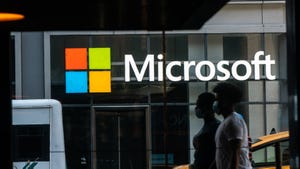Intel Sales Miss as Data Center Demand Slows
The lucrative cloud data center surge slowed in the fourth quarter, raising concern that those large customers are becoming more cautious.
January 25, 2019

Ian King (Bloomberg) -- Intel Corp. reported lower-than-projected fourth-quarter sales and profit and gave a disappointing forecast for the current period, signaling the long boom in spending to build out cloud computing centers is tapering off. Shares tumbled in late trading.
Sales in the December quarter were $18.7 billion, short of the average analyst estimate of $19 billion. Revenue in the current period will be about $16 billion and profit will be 81 cents a share, Intel said Thursday in a statement. Analysts polled by Bloomberg had estimated sales of $17.3 billion and earnings of 96 cents a share.
Intel’s growth has been fueled by some of the biggest companies in technology, such as Amazon.com Inc., Alphabet Inc.’s Google and Microsoft Corp., as they poured money into data center expansions. That lucrative surge slowed in the fourth quarter, raising concern that those large customers are becoming more cautious. Those clients have accumulated inventory and are now cutting orders while they work through their stockpiles, Chief Financial Officer Bob Swan said in an interview.
Global economic growth is slowing amid the possible impact of "geopolitical dynamics," Swan also said, and the company cited "softer China demand" for the slowdown in data-center revenue.
In the fourth quarter, Intel said net income was $5.2 billion, or $1.12 a share. Analysts projected earnings of $1.17 a share. Revenue from Intel’s data center group rose 9 percent, a steep deceleration from the third quarter, when that division’s sales notched up 26 percent. Aaron Rakers, an analyst at Wells Fargo, was looking for sales growth of 13 percent for the data-center group in the fourth quarter.
The chipmaker’s shares dropped 6.4 percent in extended trading after the report. They closed at $49.76 in regular New York trading before the report. The stock rose 1.7 percent in 2018, a better performance than the benchmark Philadelphia Stock Exchange Semiconductor Index, which slid 7.8 percent for the year.
Intel’s processors are at the heart of most of the world’s laptop and desktop computers. The company also dominates the profitable market for chips that run servers -- the machines that provide the backbone of the internet and corporate networks. Spending by cloud-computing companies helped drive Intel’s sales and earnings to record levels in 2018.
But for 2019, Intel predicted revenue of about $71.5 billion, missing average projections of $73 billion. While that would be a record for the company’s sales, it would represent the slowest annual growth rate since 2015.
Global shipments of personal computers, the market that provides Intel with the majority of its profit, declined 4.3 percent in the fourth quarter, according to Gartner Inc., as political and economic uncertainty reduced consumer demand, even during the holiday season.
Still, Intel’s division that makes PC processors saw sales improve in the period, even in a slowing market. Revenue rose 10 percent from a year earlier to $9.8 billion. While volumes were down, average selling prices rose for both desktop and laptop parts.
The company has recently struggled to transition its factory network to more advanced techniques. That left Intel short of capacity last year. In response, the company prioritized chips that it can charge more for -- server and high-end desktop processors -- causing shortages in some areas. That may have helped boost profit margins and caused customers to over-order, according to Sanford C. Bernstein analyst Stacy Rasgon.
Intel initially sparked concern last year that it may be losing its edge in manufacturing when the Santa Clara, California-based company confirmed that it won’t mass-produce chips made with 10-nanometer technology until later this year. That revised schedule may put it behind rivals such as Taiwan Semiconductor Manufacturing Co.
Intel��’s manufacturing lead has helped relegate Advanced Micro Devices Inc., its only remaining competitor in computer processors, to less than 20 percent of industry revenue. AMD, which now outsources production to TSMC, promised 7-nanometer server chips this year, a timeline that would give it a lead over Intel in that metric for the first time ever. Better production, achieved by shrinking the tiny circuits that give processors their functions, allows chips to count faster, use less energy or be produced more cheaply.
Intel is also still searching for a chief executive officer. Swan has been serving as interim CEO since the departure of Brian Krzanich, who was removed in June after the chipmaker learned he’d had a relationship with a subordinate.
About the Author
You May Also Like




.jpg?width=300&auto=webp&quality=80&disable=upscale)




